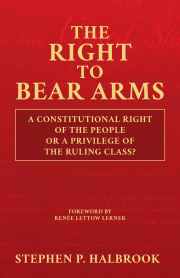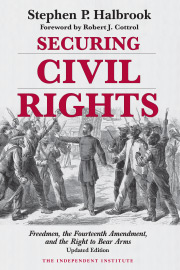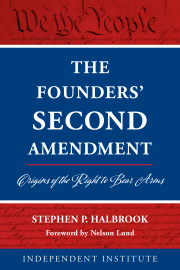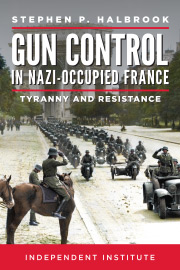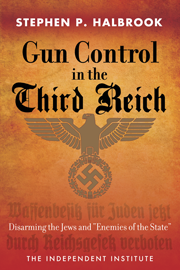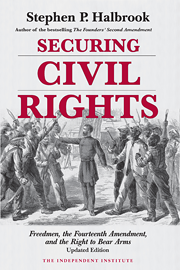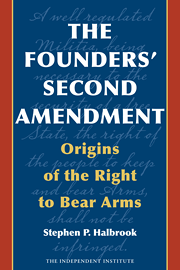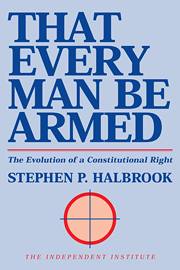The case of Snope v. Brown has been distributed for the Supreme Court’s conference for December 13. Previously styled Bianchi v. Brown, the cert petition challenges Maryland’s “assault weapon” prohibition which the Fourth Circuit upheld en banc earlier this year.
The Wall St. Journal’s Editorial Board just took notice in “AR-15 Rifles and the Constitution” (Dec. 8), observing that the Fourth Circuit “second-guesses people who say they keep or bear an AR-15-style rifle for self-defense.” It concludes: “But the Second Amendment isn’t an inkblot on the Constitution. It means something. Can that possibly not include a right to own the gun that claims to be America’s bestselling rifle?”
Now for a deeper dive. Essential to the majority’s decision was a sadly-mistaken view of the quite ordinary ammunition that the banned rifle typically fires.
Back on March 20, the case was being argued before the Fourth Circuit en banc. Judge Harvie Wilkinson noted that “Heller talks about M16s and the like, weapons of war,” and another judge chimed in that “the AR15 is the M16.” That was the basis on which the court previously upheld the ban, which was now back in the court because the Supreme Court vacated and remanded the case for reconsideration in light of Bruen.
Judge Wilkinson asked appellants’ counsel Pete Patterson: “Have you ever fired an M-16?” Counsel: “I have not your Honor.” Judge Wilkinson: “Well I have and we used them when I was in the Army Reserve. That was way back, way way back.” (He served in 1968-69.) Judge Wilkinson went on to state:
And when we took shots at the targets, wherever we hit, there was nothing left, the kick was so powerful that when the bullets hit the human beings, it splintered them into all sorts of little pieces, there was very little left of the human being, and that was a very earlier model of the M16, and since then it’s been perfected, and perfected, and perfected into an even more lethal weapon than the ones that I used.
Actually, both back then and now, the M16 (like most AR-15s) fires the relatively-underpowered 5.56 mm cartridge. It has very little kick. And while obviously the 5.56 can be lethal, in no way does it even come close to “splintering” a human into “little pieces.” It won’t even do that to a squirrel.
While the rhetoric was toned down when the en banc decision was issued on August 6, what it said would still make any person familiar with firearms wonder what planet the court is on. But first let’s conduct a reality check on the characteristics of different higher-powered and lower-powdered rifle cartridges.
For over a century, millions of American deer hunters have chosen the .30-06 round. That is what our Armed Forces used in the M1903 bolt action rifle and the M-1 Garand semiautomatic rifle. The .308 or 7.62 cartridge, which the military used in the M-14 rifle, perhaps became the most popular deer round for a time. There are numerous other rounds on the market of equal or better take-down power, such as the 6.5 Creedmoor.
In 1950, the .222 Remington cartridge was developed for varmint hunting. It evolved into the .223 Remington round, which in turn became the basis of the 5.56 mm cartridge adopted by the military for use in the M16 and favored by many target competitors. Neither round is preferred by deer hunters, as most loads are too underpowered to harvest big game.
Maryland game regulations require that rifles used for deer hunting must use ammunition developing a muzzle energy of at least 1,200 foot pounds. A typical 5.56 with a normal 55 grain bullet generates 1,223 ft.-lbs. of muzzle energy. By contrast, a .308 round with a 150-grain bullet fires with 2,648 ft.-lbs. of muzzle energy, over double that of the 5.56.
As is plain to see, the power of the .223/5.56 round isn’t much to speak of compared to typical hunting rounds. It is so underpowered that the Armed Forces are replacing its 5.56 M16 and M4 rifles with a new 6.8 x 51 mm round (the XM7) which has muzzle energy of 2,267 ft-lbs with a 135 grain bullet.
Now to the decision in Bianchi, authored by Judge Wilkinson. On cartridge power, it includes a single long paragraph with citations to five district court opinions and a Washington Post article, but no expert sources. It begins: “The firepower of the AR-15 and M16 is a key component of their ‘phenomenal lethality.’” They are “[b]uilt to generate ‘maximum wound effect’ and to pierce helmets and body armor....” You can’t have it both ways. Maximizing the wound size requires a bullet with a soft nose or hollow point that expands. Piercing a helmet or armor requires a bullet with a steel core or other hard metal that will not expand.
Instead of comparing other rifle cartridges with the underpowered 5.56/.223, the court compares this rifle cartridge with handgun cartridges. Supposedly “AR-15 bullets discharge at around ‘three times the velocity of a typical handgun....’” What is a “typical” handgun? What are your calculations? Are you aware that rifles in the AR-15 configuration come in many calibers, including as small as .22 rimfire?
“These higher velocity rounds ‘hit fast and penetrate deep into the body,’ creating severe damage,” continues the court. Most bullets from most firearms have that potential. The court adds that an AR-15 bullet “yaws” or “turns sideways” in tissue, rotating and creating a large, “temporary cavity” or “blast wave” that can be “up to 11-12.5 times larger than the bullet itself”; that is known as “cavitation.” That’s from another district court opinion, not a scientific study. And it is oblivious to the fact that more powerful rifle rounds would have much more devastating effect. But that doesn’t justify banning the rifles that fire them.
This is a complex subject, and the court just didn’t do any real homework. Dr. Martin Fackler, military trauma surgeon and former director of the Army’s Wound Ballistics Laboratory, wrote in the Annals of Emergency Medicine: “The most common misconception about gunshot wound treatment is that the penetration of any ‘high-velocity’ bullet causes enigmatic ‘shock waves’ and cavitation that will doom tissues even far from the bullet path.”
Regarding rounds fired from the M16, Dr. Fackler wrote in Wound Ballistic Review that “most often the bullet travels about five inches through flesh before beginning significant yaw. But about 15% of the time, it travels much farther than that before yawing—in which case it causes even milder wounds, if it misses bones, guts, lung, and major blood vessels.” In Vietnam, it was found that many bullets passed through torsos “traveling mostly point forward, and caused minimal damage.”
The Bianchi court next inappropriately compares wounds from rifles to those from handguns. It asserts that a “typical 9mm [bullet] wound to the liver” from a Glock 19 handgun “will produce a pathway of tissue destruction in the order of one inch to two inches,” but an AR-15 wound “will literally pulverize the liver, perhaps best described as dropping a watermelon onto concrete.” Hyperbole aside, a .30-08 deer rifle round would cause much more injury. Again, should deer rifles be banned?
While we’re comparing rifles to handguns, consider the 7.62 x 39 full metal jacket round used in the AK-47 (which Maryland bans) and the SKS (not banned). Dr. Fackler notes that it “does not deform in tissue and travels about 26 cm [10.2 inches] before beginning to yaw. This explains the clinical finding that most wounds caused by this bullet resemble those made by much lower velocity handgun bullets.”
Bianchi tells us that the “catastrophic” damage of AR-15 rounds leaves “multiple organs shattered,” bones “exploded,” and “soft tissue absolutely destroyed,” which “often cannot be repaired” by trauma surgeons. That potential exists for wounds from shots fired from firearms of almost any kind.
A cartridge does not care what type of firearm fires it. A .223 round fired from an AR-15 will cause exactly the same wound as one fired from a single-shot rifle that Maryland does not ban. Yet the Bianchi court seeks to justify the ban on certain rifles based on the wounding potential of the cartridge they fire when countless other rifles fire exactly the same cartridge. Presumably all rifles that fire this cartridge, not to mention all that fire more powerful cartridges, may be banned. That would be most rifles other than the .22 rimfire.
Descriptions of wounds in the most gory manner possible to justify a gun ban loses sight of the fact that the Second Amendment protects “arms,” which include “any thing that a man wears for his defence, or takes into his hands, or useth in wrath to cast at or strike another.” (Heller, quoting Timothy Cunningham’s 1771 legal dictionary.) That criminals injure and kill innocents with arms is reason for innocents to have arms, not to ban them.
There is much more to the Bianchi’s majority opinion, and Judge Richardson (joined by four other judges) does an able job in refuting the arguments. As a side note, he knows about firearms, writing: “Speaking from experience, many hog hunters deploy the exact weapons that Maryland bans, including the AR-15.”
David Kopel’s post on this blog from last year—“How powerful are AR rifles?”—provides a detailed review of the issues herein. At a more general level, my book America’s Rifle: The Case for the AR-15 discusses the broader, historical context of the issue.



